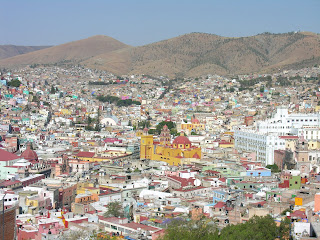
On the morning of September 16, 1810, Father Miguel Hidalgo y Costilla, the local priest in the small town of Dolores, issued the cry for Mexican independence. Known as the “Grito de Dolores” (Shout or Cry of Dolores), Hidalgo called for the local indigenous people and the mestizos to take Mexico from the Spanish king.
Hidalgo and many other Criollos, Mexican-born Spanish who were treated as second-class citizens by the ruling Spanish aristocracy, were already in the planning stages of a revolution against the Spanish. However, their plan was betrayed, and another of the leaders, Ignacio Allende, had ridden the night before to warn Hidalgo of the situation.
Following a massacre of the Spanish population in Dolores, Hidalgo and the Dolores farmers made a circuitous march through the rugged mountains to the regional mining center of Guanajuato, increasing their numbers along the way. Upon the arrival of the rebels, the local Spanish aristocracy barricaded themselves in the massive stone Alhondiga de Granaditas, or grain warehouse.

The granary seemed like the perfect fortress, and combined with their superior weaponry, it allowed the Spanish to hold off the revolutionaries -- until one man turned the tide of the battle. Born with a birth defect, Juan Jose de los Reyes Martinez was a local man ridiculed for walking in a way that reminded others of a hen turkey or “pipila.” But on September 28, 1810, Juan became a national hero when he used a large flat stone tied to his back to protect him from the Spanish bullets and charged to the wooden door of the granary. Juan set fire to the door, which provided access to the granary for his compatriots. They stormed inside and won the first significant battle of the Mexican War of Independence. Today, Juan is revered as El Pipila, and his statue watches over the city of Guanajuato.

Despite their loss at Guanajuato, the Spanish did not cede power immediately. Within a year, Father Hidalgo, Ignacio Allende, and two other leaders of the independence movement were captured and shot. For 10 years, their four heads hung from the four corners of the granary as a deterrent to other revolutionaries.


But the revolutionaries fought on, and on August 24, 1821, Spain signed the Treaty of Cordoba, which recognized Mexican independence. For more detailed information about Father Hidalgo and the Mexican War of Independence, see http://www.mexonline.com/mexican-independence.htm and the entry for the Mexican War of Independence at wikipedia.org.
Today, the town of Dolores, renamed Dolores Hidalgo to memorialize its place in Mexican history, seems an unlikely birthplace for a revolution.


The Plaza d’ Armas has been converted into a landscaped garden where families stroll and musicians play. Ice cream vendors, known for their exotic and varied flavors such as avocado and chile, are on every corner .

But the city remains well-known for its ceramics industry, which has descended from the pottery skills that Father Hidalgo taught to the indigenous people here. And the church from which Father Hidalgo issued his famous cry for independence is being restored for the bicentennial celebration that is coming in just 18 months.




About 40 km. down the road, another town has also changed its name to memorialize its role in the War of Independence. In honor of its famous native son whose head hung from the granary in Guanajuato along with that of Hidalgo, “San Miguel el grande” is now San Miguel de Allende.








































